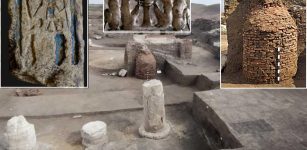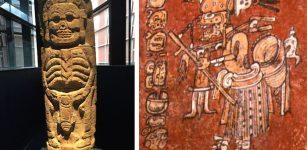Anu: Supreme Ruler Of The Heavenly Abode In Sumerian Pantheon Of Gods
A. Sutherland - AncientPages.com - The Sumerian pantheon included many deities but initially, the most important of them were Anu, Enlil, Enki, and Ninhursag. In this article, we present Anu (also known as An), the Great Father of the Sky who belonged to the oldest generation of Mesopotamian gods.
Cuneiform texts including Sumerian creation accounts and the Babylonian epic Enuma Elish are the main sources that give us knowledge about Anu who had many titles such as lord of constellations, king of gods, spirits, and demons.
In the Assyrian-Babylonian pantheon, he was both, the god of kingship as well as the ruler of heaven.
Anu’s Sumerian cult center was White Temple in the sacred precinct of Kullaba at Uruk (today modern Warka); he was also worshiped in Ur and Lagash.
At first, Anu was the most powerful of the gods, and all the others in the Sumerian Pantheon treated whim respectfully, as he was a great authority; however, he rarely showed up in the myths and hymns of Mesopotamia.
Anu has always been portrayed as being very distant from ordinary people and their daily concerns. It was understood that as a supreme ruler, he must have had other, much more important matters to attend to.
In heaven, he had power over other gods and decided about their functions, privileges, and responsibilities, increasing their status at will. On earth, he discussed kingship, and his decisions were regarded as permanent.
The oldest texts do not mention the origin of Anu. In the Babylonian creation myth Enuma Elish (Tablet I, 11-14)), there is a mention that Anu was the son of a primordial god, Anshar ("whole heaven"), and his consort, Kishar ("whole Earth").
1. When in the height heaven was not named,
2. And the earth beneath did not yet bear a name,
3. And the primeval Apsû, who begat them,
4. And chaos, Tiamat, the mother of them both,—
5. Their waters were mingled together,
6. And no field was formed, no marsh was to be seen;
7. When of the gods none had been called into being,
8. And none bore a name, and no destinies [were ordained];
9. Then were created the gods in the midst of [heaven],
10. Lahmu and Lahamu were called into being [...].
11. Ages increased, [...],
12. Then Anshar and Kishar were created, and over them [...].
13. Long were the days, then there came forth [...]
14. Anu, their son... [...]
Anu is often mentioned as the "father of gods," because many Sumerian deities are considered to be his children. This of course depends on the literary sources, but we find the names of Enki, Nanna, Enlil, Inanna, Nanaya, and many others. The first known recording of his name occurs on the inscription of Mesanepada, King of Ur, which reads "Young man, chosen by Ana". This inscription dates from around 2,700 - 2,600 BC.
With the passage of time, this supreme god became a rather obscure character in the Sumerian pantheon. Eventually, his position was taken over by his son Enlil, Lord of the Winds, Marduk, and the goddess Inanna.
Mesopotamian gods were shown in human form and accompanied by their sacred beasts and so was also Anu whose animal was a bull. Anu‘s insignias were: the Scepter, symbolizing power, the tiara, his divine headdress, and the staff provided by the shepherd.
It is believed that Anu was symbolically depicted on seals and seal impressions from 3.000 BC onward. Otherwise, Anu was rather seldom represented in art, except for Kassite and Neo-Assyrian art, in which his symbol was a horned cap.
He was worshiped from about 3500 BC to 2000 BC and continuously as Babylonian creator god until 100 BC or later. There were many temples scattered through Mesopotamia devoted to Anu.
Written by – A. Sutherland AncientPages.com Staff Writer
Copyright © AncientPages.com All rights reserved. This material may not be published, broadcast, rewritten or redistributed in whole or part without the express written permission of AncientPages.com
Expand for referencesReferences:
Kramer, S. N. Sumerian Mythology
Macleod, Kezip. Legends of Sumer
More From Ancient Pages
-
 Fashion Police Enforced Gender Norms In Early Modern Genoa
Social Sciences | Dec 11, 2024
Fashion Police Enforced Gender Norms In Early Modern Genoa
Social Sciences | Dec 11, 2024 -
 On This Day In History: Battle Of Dormans Was Fought – On October 10, 1575
News | Oct 10, 2016
On This Day In History: Battle Of Dormans Was Fought – On October 10, 1575
News | Oct 10, 2016 -
 Can Discovered Algonquian Artifacts Solve Mystery Of The Lost Colony On Roanoke Island?
Archaeology | May 13, 2024
Can Discovered Algonquian Artifacts Solve Mystery Of The Lost Colony On Roanoke Island?
Archaeology | May 13, 2024 -
 Were The Bones Of Fallen Battle of Waterloo Soldiers Sold As Fertilizer? – New Study
Archaeology | Jun 18, 2022
Were The Bones Of Fallen Battle of Waterloo Soldiers Sold As Fertilizer? – New Study
Archaeology | Jun 18, 2022 -
 Ancient Egyptian Visual Depiction Of The Milky Way Discovered
Archaeoastronomy | May 2, 2025
Ancient Egyptian Visual Depiction Of The Milky Way Discovered
Archaeoastronomy | May 2, 2025 -
 Mysterious Advanced Underground Civilization And A Secret Society – Dangerous Knowledge And Verdict – Part 3
Ancient Mysteries | Apr 24, 2018
Mysterious Advanced Underground Civilization And A Secret Society – Dangerous Knowledge And Verdict – Part 3
Ancient Mysteries | Apr 24, 2018 -
 The Hittites – Rise And Fall Of An Ancient Powerful Empire
History | Feb 18, 2019
The Hittites – Rise And Fall Of An Ancient Powerful Empire
History | Feb 18, 2019 -
 Modern Horses Have Lost Their Additional Toes, Scientists Confirm
Evolution | Jun 21, 2023
Modern Horses Have Lost Their Additional Toes, Scientists Confirm
Evolution | Jun 21, 2023 -
 Did Human Middle Ear Evolve From Fish Gills? – Chinese Fossils Reveal
Archaeology | Jun 17, 2022
Did Human Middle Ear Evolve From Fish Gills? – Chinese Fossils Reveal
Archaeology | Jun 17, 2022 -
 When Giants Ruled North America – Giant Skeletons ‘Erased’ From History – Part 2
Ancient Mysteries | Nov 22, 2018
When Giants Ruled North America – Giant Skeletons ‘Erased’ From History – Part 2
Ancient Mysteries | Nov 22, 2018 -
 Remains Of Colonnaded Hall Of 26th Dynasty Found At Ancient Buto Temple, Northern Nile Delta
Archaeology | Nov 18, 2022
Remains Of Colonnaded Hall Of 26th Dynasty Found At Ancient Buto Temple, Northern Nile Delta
Archaeology | Nov 18, 2022 -
 Ah Puch: Evil Death God Of Underworld Who Hated Souls In Maya Beliefs
Featured Stories | Feb 16, 2018
Ah Puch: Evil Death God Of Underworld Who Hated Souls In Maya Beliefs
Featured Stories | Feb 16, 2018 -
 On This Day In History: The Only English Pope In History Of Catholic Church Elected – On Dec 4, 1154
News | Dec 4, 2016
On This Day In History: The Only English Pope In History Of Catholic Church Elected – On Dec 4, 1154
News | Dec 4, 2016 -
 Stone Age Infants Received Care For Nine Hours Per Day From Up To 15 Different Caregivers – Study Informs
Archaeology | Nov 15, 2023
Stone Age Infants Received Care For Nine Hours Per Day From Up To 15 Different Caregivers – Study Informs
Archaeology | Nov 15, 2023 -
 Has The Mystery Of Cerne Abbas Giant Been Solved?
Archaeology | Jan 2, 2024
Has The Mystery Of Cerne Abbas Giant Been Solved?
Archaeology | Jan 2, 2024 -
 On This Day In History: Admiral John Byng Charged With ‘Failing To Do His Utmost’ – Executed – On Mar 14, 1757
News | Mar 14, 2017
On This Day In History: Admiral John Byng Charged With ‘Failing To Do His Utmost’ – Executed – On Mar 14, 1757
News | Mar 14, 2017 -
 Extraordinary Discovery: Clay Vessel With Sour Soup For The Gods Found In Medieval Hut
Archaeology | Jun 4, 2017
Extraordinary Discovery: Clay Vessel With Sour Soup For The Gods Found In Medieval Hut
Archaeology | Jun 4, 2017 -
 Ancient Burial Chambers Decorated With Mythological Figures Of Hercules, Medusa, Eros – Unearthed In Bursa, Turkey
Archaeology | Feb 21, 2017
Ancient Burial Chambers Decorated With Mythological Figures Of Hercules, Medusa, Eros – Unearthed In Bursa, Turkey
Archaeology | Feb 21, 2017 -
 Strange Ancient Measurements Of The Earth Revealed – Ancient Texts And Physical Evidence Examined
Ancient Mysteries | Apr 11, 2018
Strange Ancient Measurements Of The Earth Revealed – Ancient Texts And Physical Evidence Examined
Ancient Mysteries | Apr 11, 2018 -
 500-Year-Old Transylvanian Diaries Reveal How The Little Ice Age Transformed Life And Death In The Region
Archaeology | Feb 12, 2025
500-Year-Old Transylvanian Diaries Reveal How The Little Ice Age Transformed Life And Death In The Region
Archaeology | Feb 12, 2025


